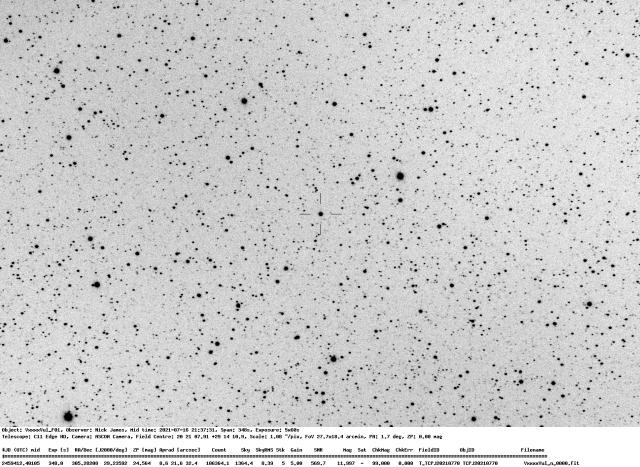Forum Replies Created
-
AuthorPosts
-
 Nick JamesParticipant
Nick JamesParticipantThere is a high res map of the lava flow here. You are a little way off the top of the frame.
 Nick JamesParticipant
Nick JamesParticipantAlex. I’ll pass on your request and I’ll see if we can make it as dark as Headingly on a mid-summer’s day.
 Nick JamesParticipant
Nick JamesParticipantEeek. A bit close! At least we don’t have to worry about volcanic dust clouds when observing from the UK. There is some quite spectacular footage on the Reuters site here. The pictures from El Paso and Los Llanos look very familiar.
 Nick JamesParticipant
Nick JamesParticipantThe reason for the pre-booking is that the IoP have decided to restrict the numbers in the lecture theatre to around 70 and this helps us assess how many people are likely to come. I doubt if that will be a problem for the AGM but it will be potentially more of a problem for Christmas. As with everything Covid-related things can change quickly but I hope that this meeting can go ahead since I am really looking forward to getting back to face-to-face meetings after a long break.
In the last few months I’ve been to many crowded events and have managed to survive but I know that some people will prefer to stay away, or are just too far away for convenient travel, so we will be livestreaming the meeting on Youtube. The IoP have been very helpful with this and it will probably become a permanent feature.
 Nick JamesParticipant
Nick JamesParticipantI don’t have a view on whether planetary observers should have north or south up but I do wish that they would be consistent. When I’m doing Sky Notes I either have to have some slides with the original caption text upside down or the planet just flips back and forth in an irritating way.
Don’t get me started on the random orientations and even mirror imaged views that you see for Deep Sky objects (and also comets if truth be told).
 Nick JamesParticipant
Nick JamesParticipantA link to Mike’s blog in in Jeremy’s post. That contains his bio and contact details.
 Nick JamesParticipant
Nick JamesParticipantThe summary on the National Trust collections page is “interesting”. Next time a nearby supernova goes off we clearly need to go around wearing hard hats.
 Nick JamesParticipant
Nick JamesParticipantThat’s a very impressive spectrum given that the current total magnitude of 4P is about 12. It is one of the brighter comets around at the moment and definitely worth following although it is a morning object. Current images are here.
 Nick JamesParticipant
Nick JamesParticipantThe last two nights it has been brighter than mag 15 so the outburst looks to be on schedule. Tonight (Sept 6) I have 14.7 unfiltered.
10 August 2021 at 3:15 am in reply to: Comet 17P/Holmes has its first strong outburst for >6 years #584587 Nick JamesParticipant
Nick JamesParticipantHere’s an image taken this morning (Aug 10) from Chelmsford. It is around mag 16.1 in a 9.2 arcsec aperture. My most recent previous image was July 29 when it was 17.1.
 Nick JamesParticipant
Nick JamesParticipantYes, 2021! Corrected and Yes, the CBET is from Dan Green.
 Nick JamesParticipant
Nick JamesParticipantCBET 5007 has designated this as Nova Vul 2021 = V606 Vul. To quote: “R. Leadbeater, Wigton, U.K., writes that a low-resolution (R about 500) spectrogram taken on July 16.915 UT (instrumentation not specified) shows strong Balmer lines in emission showing P-Cyg profiles with an estimated velocity of about 1400 km/s, adding that there are other broad emission lines including He; the spectrogram has been posted at website URL https://britastro.org/specdb/data_graph.php?obs_id=10094.”
 Nick JamesParticipant
Nick JamesParticipantInteresting to read that ATEL. I’ve managed to observe it on 12 of the 14 nights since discovery and my unfiltered photometry shows it still rising as of last night.
 Nick JamesParticipant
Nick JamesParticipantSort of. They still allow DATE-OBS to be anything the developer likes as long as it is indicated in a comment. That means that you have to parse comments to find out what the keyword means. That is a pretty rubbish “standard” in my view. As an engineer the FITS standard is pretty much the kind of thing that I would expect a scientist to write…
 Nick JamesParticipant
Nick JamesParticipantThe FITS “standard” is irritatingly vague about things like this and, particularly for astrometry, it is really important to know what DATE-OBS means. In most software these days it is the time that the exposure starts but sometimes it isn’t. In “good” software there is often a comment along the lines of:
DATE-OBS= ‘2021-07-26T22:03:10’ / Start of exposure
but often there isn’t and so it is always worth checking for whatever image acquisition and processing software you use.
 Nick JamesParticipant
Nick JamesParticipantStewart, Yes, it’s back up to 5.6 unfiltered tonight (July 26) which is not far short of its brightest at the previous peak. I’m doing 1s exposures and it is not far off saturating my camera. It is very hazy here but I think I’ll get the binoculars out again.
 Nick JamesParticipant
Nick JamesParticipantThe nova is about 0.3 mag brighter tonight (July 20) than it was yesterday. My unfiltered photometry is around 0.4 mag brighter than V band since the nova is so red but the trend is pretty clear. Of the other novae around V1405 Cas is brightening again although still around a magnitude below its brightest and V1674 Her is very gradually fading after its initial rapid decline.
 Nick JamesParticipant
Nick JamesParticipantYes, it looks to be at the bottom of a cycle.
 Nick JamesParticipant
Nick JamesParticipantHere’s the field. I get it around mag 12 (unfiltered re Gaia G) and a position of 20:21:07.71 +29:14:08.9 (Gaia DR2).

 Nick JamesParticipant
Nick JamesParticipantMy last observation was on July 7.9 at 16.52. It’s in the BAA database. Richard Sargent also got some observations later that night at around 16.10. They are in the database too.
-
AuthorPosts
